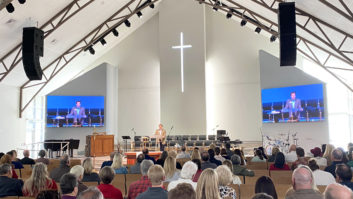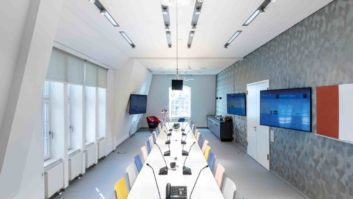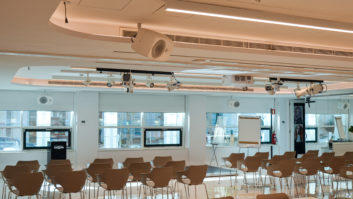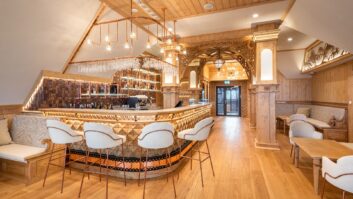The office, usually used as a general term for a place of work, always seemed like a constant in people’s lives. Until recently, company identities were often based around the corporate premises, where all the employees came to do their jobs. Working from home did happen but there was the disparaging view that it was not ‘real’ work. That all changed with Covid, when many companies relied on staff keeping the business going from their homes, something enabled by not only telephone and internet connectivity but also audio-visual equipment such as microphones, headphones and soundbars.
Post-pandemic and the debate continues over whether working from home (WFH) will continue or if there is to be a gradual move towards getting people back into the office. A report by the EU work/employment research agency Eurofound, The Rise in Telework: Impact on Working Conditions and Regulations, published in December, concludes that what it classifies as ‘teleworking’ – WFH by another name – is “here to stay”. It shows 41.7 million employees teleworked across the EU in 2021, double the number since 2019.
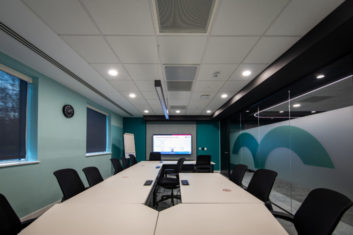 As might be expected, there was a decrease during 2022 but Eurofound describes this as only a “small decline”. In general the conclusion is that WFH is an “upward trend” that is “set to resume as technological developments are increasing the number of teleworking jobs”, with employee and employer preferences leaning more towards remote working. There are some who are working against this new way of getting business done, notably Elon Musk. The new owner of Twitter is demanding that staff work Monday to Friday in the office. From a UK perspective, Transport for London (TfL) is reporting increasing passenger numbers – with the London Underground seeing usage rise to 75 to 80 percent of what it was before the pandemic, while bus passenger figures on some routes in outer London have returned to pre-2020 levels.
As might be expected, there was a decrease during 2022 but Eurofound describes this as only a “small decline”. In general the conclusion is that WFH is an “upward trend” that is “set to resume as technological developments are increasing the number of teleworking jobs”, with employee and employer preferences leaning more towards remote working. There are some who are working against this new way of getting business done, notably Elon Musk. The new owner of Twitter is demanding that staff work Monday to Friday in the office. From a UK perspective, Transport for London (TfL) is reporting increasing passenger numbers – with the London Underground seeing usage rise to 75 to 80 percent of what it was before the pandemic, while bus passenger figures on some routes in outer London have returned to pre-2020 levels.
HYBRID WORKING
In between these polarised positions is hybrid working, which is most likely how companies will continue to run in the future, with people spending time in the office one or two days a week and the rest at home. To make this work calls for efficient and stable video conferencing connections, with professional equipment at either end. AV trade organisation AVIXA’s annual pro AV industry forecast, the Industry Outlook and Trends Analysis (IOTA), shows global spending on conference rooms, huddle spaces, individual office space and flexible/hybrid areas was approximately $52 billion in the AV market during 2022.
Sean Wargo, senior director of market intelligence for AVIXA, comments that the market has been affected by shifts towards more flexible working modes as employees increasingly work remotely. “Conferencing/collaboration is one of the few areas of AV spending that actually maintained growth through the pandemic as most markets worked to maintain their business operations through investment in collaboration technology,” he says. “A lot of that spending was put towards cloud-based services like Teams or Zoom licensing. But once you strip that out, audio equipment rises to the top of the list of AV hardware investment, capturing 21 percent of the hardware revenues within conferencing and collaboration. This includes headphones/headsets, microphones, loudspeakers, digital signal processors, audio conferencing systems and amplification.”
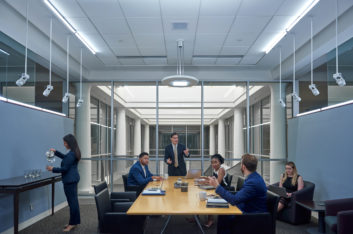 As for innovation, Wargo identifies network connectivity as the area that has seen “a big push” in the field of audio. “Dante is an example here but so too is Bluetooth, as we think of devices that would connect to in-room systems or laptops,” he says. “You can see this via product introductions from companies like HP and Logitech. One might reasonably expect to see similar product evolution from more core audio manufacturers over time as well. Bundling of product with some supporting cloud-based services would also make sense, perhaps for content streaming, remote monitoring, and configuration.” Wargo expects the way audio systems are connected and how they link to other devices will be “a big theme” at ISE 2023 and at InfoComm in June.
As for innovation, Wargo identifies network connectivity as the area that has seen “a big push” in the field of audio. “Dante is an example here but so too is Bluetooth, as we think of devices that would connect to in-room systems or laptops,” he says. “You can see this via product introductions from companies like HP and Logitech. One might reasonably expect to see similar product evolution from more core audio manufacturers over time as well. Bundling of product with some supporting cloud-based services would also make sense, perhaps for content streaming, remote monitoring, and configuration.” Wargo expects the way audio systems are connected and how they link to other devices will be “a big theme” at ISE 2023 and at InfoComm in June.
THIRD GENERATION
Dante developer Audinate has targeted the audio-visual market, including corporate, with tailored products such as Dante AV. The third generation of the Dante AV Brooklyn networking module is now shipping; Audinate is also working with Bolin and Yamaha to produce single system conference installations. These are based on Yamaha’s ADECIA ceiling microphone conferencing system and Bolin 4K/full HD Dante AV-native PTZ cameras, with the aim of creating collaboration spaces running professionally timed audio and video on one network switch.
Bluetooth has been providing connectivity for nearly 25 years, initially in the consumer and telecom areas but increasingly for professional AV applications. This has been pushed by the introduction of high definition audio versions through processing systems such as aptX HD Bluetooth. Another possible infrastructure technology for connecting microphones and headphones is ultra wide band (UWB), a short-range, high bandwidth communications protocol that is able to work on low energy levels.
The core technology behind UWB has been around since the earliest days of radio transmissions but, in recent years, has been embraced by modern tech companies, including Apple, which introduced three iPhones featuring the format in 2019 and continues to launch products incorporating it. Even so, Bluetooth hangs on, particularly with the boost of aptX HD. In corporate AV, Bluetooth is providing the basis for wireless microphones that are used in conferencing systems. When combined with other units and technologies, explains Will Turney, head of the integrated solutions division of POLAR Audio, these are capable of improving both the quality of conference calls and how the user experiences them.
“The corporate AV space has changed a lot in the last few years,” he says. “When people were in the office it was about getting the best audio experience possible. There might have been one or two people joining from distance but most were in the office. During the pandemic there was the shift to where everyone was working in different environments and more people were spending more time on video calls. If the remote participants were using headsets and headphones, that gives a good audio experience in the home environment because it reduces distractions such as the dog running around or family members in the background. It also allows the mic to be close to the mouth, which produces good audio quality.”
SUITABLE PRODUCTS
Even with this general outline of suitable products for conferencing and corporate AV in general, Turney says there is “no one size fits all” when it comes to equipment. “We are seeing a lot of different strategies being adopted or looked at,” he explains. “I don’t think there is a clear strategy for people now [post-pandemic]. Some companies are asking staff to come back two to three days a week but a vast majority of people is not back in the office and the problems of hybrid working are not being highlighted. In terms of communications, audio is the most important thing. If the video cuts out you can carry on but if the audio goes, that’s the end of the conversation.”

Along with good quality, Turney views simplicity as a key factor in corporate and conferencing systems. There is also the realisation that, with the length of time people are now spending on video calls, it is important they are not unduly fatigued by having to listen to sound that is difficult to hear.
“Audio is being viewed with more attention and importance than ever before in corporate AV,” comments Ken Morrison, sales director of Sennheiser UK. “Many meeting rooms were equipped with gear that would ‘make do’. Now we’re using this technology more frequently, the need for quality audio becomes more habitual and expected because we all know how exhausting it can be to listen to bad audio for prolonged lengths of time.”
Morrison’s colleague, business development manager Inesh Patel, picks up on the fatigue caused by bad sound, saying it can make those listening less attentive, which reduces the effectiveness of the meeting. Patel adds that quality is crucial but the type of equipment being used has changed: “Until recently the technology used in professional broadcast filtered down to the commercial and then consumer sectors,” he says. “Now the trend has reversed, where we see consumer products – the smartphone being a prime example – dictating what is used in business and even broadcast. The paramount thing to understand from this is an appreciation of scale. Where something used at home for personal use works well, when you try to use something designed for a smaller room application in a larger room at work, the results can often be poor.”
As an example Patel cites the soundbar, which has now achieved a certain ubiquity in home entertainment setups, which he says is “great” for small spaces but for larger rooms “a more multi-component approach” is necessary. “Beam-forming microphone technology has become a game-changer in the meeting room environment because it has enabled users to get away from being close to the mic but with little or no compromise on the audio,” he says. “Also noise suppression features are now often present on soft codec platforms to help the audio call quality in general by reducing any annoying background noise, such as heating, ventilation, air conditioning or even typing on keyboards.”
SOFT CODECS
Soft codecs such as Zoom and Teams, which may also extend to the cloud, have played a major role in making a success of remote conferencing – and, by extension, WFH – but, observes Ekin Binal, director of product management for AV solutions at Crestron, sound is the real foundation of meeting calls. “Expectations of what a meeting can be have been raised in the past three years,” he says. “It really starts with audio because you can connect using audio only, so there is more importance attached to it. Everyone has a mobile device and a headset and they can walk down the street using a soft codec like Teams or Zoom to be on a conference call. The quality is now pretty good because machine learning [ML] can be used to detect background noise.”
With this realisation that how a meeting sounds is important, not just on a technical level but also how it can enhance the conference itself, Binal says companies are now thinking about the right kind of rooms for holding hybrid meetings. “People are now doing everything they can to provide the best starting point,” he explains. “They are looking at the conditions in the conference room, including whether it is reverberant. Glass walls are very popular in offices but that’s a large reflective surface. Customers are now listening to advice about that [to get good sound] rather than just going with what the architect proposes.”
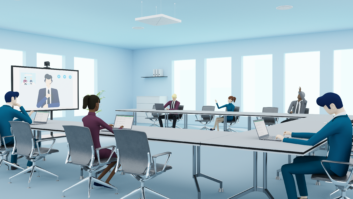 The goal, Binal adds, is not to “impede or distract from voice quality.” As well as recommending that rooms have the best possible acoustics, Crestron is also offering technologies based on ML and AI to optimise sound performance. This includes a partnership with Shure, which has seen its IntelliMix Room software-based audio processing system for AV conferencing integrated with Crestron’s XiO Cloud management platform. Together these allow audio to be monitored and managed, with the ability to set up sessions quickly and run them remotely if required.
The goal, Binal adds, is not to “impede or distract from voice quality.” As well as recommending that rooms have the best possible acoustics, Crestron is also offering technologies based on ML and AI to optimise sound performance. This includes a partnership with Shure, which has seen its IntelliMix Room software-based audio processing system for AV conferencing integrated with Crestron’s XiO Cloud management platform. Together these allow audio to be monitored and managed, with the ability to set up sessions quickly and run them remotely if required.
With greater emphasis being placed on audio to facilitate worthwhile meetings, there are signs that companies in the corporate sector are now taking more trouble over preparations for a project. “We know installers are extremely busy at the moment with many organisations opting to get professional advice before investing in new AV systems that can accommodate hybrid working,” comments Ian Bridgewater, director and technical sales manager with TOA Corporation UK. “We have also seen many new construction designs that are multi-functional – retail, leisure and residential – all on one site. Designers are investing in technology to encourage hybrid workers to think about using their facilities as an extension to their home/work space to support economic growth.”
SERIOUS SYSTEMS
Emma Bigg, director of AV design and strategy consultancy Octavius RE, comments there is now the need to design audio-based systems in a more serious way, taking in consideration correct placement of loudspeakers and microphones, the use of professional DSP with echo cancellation and good in-room acoustics. “It was surprising how often these elements of a meeting room solution were an after-thought or completely overlooked,” she says. “By improving the in-office design it also improves the experience for the remote participants because they can hear everyone, they can be heard clearly and this is essential for good communication that feels natural and helps people forget the screen.”
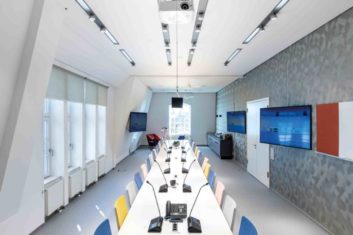 As for where this new found appreciation of audio might go in the future, Bigg is of the opinion that it might not go much further if a system is already well designed and functional. “But there are organisations investing heavily in very advanced hybrid events spaces, so corporate is starting to adopt event technology and processes, which is very interesting and does open a whole new chapter for audio and other disciplines,” she comments. “Everyone could be installing higher quality speakers and correct amplification to improve not only the output but also achieve better value for money. Things have definitely come a long way very quickly since Covid turned the world upside down.”
As for where this new found appreciation of audio might go in the future, Bigg is of the opinion that it might not go much further if a system is already well designed and functional. “But there are organisations investing heavily in very advanced hybrid events spaces, so corporate is starting to adopt event technology and processes, which is very interesting and does open a whole new chapter for audio and other disciplines,” she comments. “Everyone could be installing higher quality speakers and correct amplification to improve not only the output but also achieve better value for money. Things have definitely come a long way very quickly since Covid turned the world upside down.”
There is still, points out Tom Griffiths, application, training and support manager at Audio-Technica UK, the need for audio systems to be easy to use because they are very often used by non-AV professionals. “Innovation has to be matched to usability,” he says. “But even in fairly simple AV installations there might be multiple audio sources that need to be combined, so there has been a need to develop digital mixing solutions alongside new microphone technology.”
Beam-forming has made its mark on both mic and conference room design in the last few years. Such systems, which include the Audio-Technica ATND1061 ceiling array and Sennheiser’s TeamConnect Ceiling 2 mic, have the capability to ‘focus’ on someone speaking, wherever they are in a room. Griffiths also feels networked audio, including Dante, will continue to develop so the various devices being used in corporate AV can be connected and controlled effectively.
All of which shows that although video in the form of Zoom and Teams was hailed as the future of work in the wake of the pandemic, audio has getting on with making WFH happen in it usual unobtrusive way.
